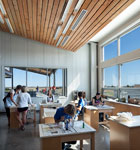At a Glance
Location
Brighton, MI
Founded
2007
Employees
87
Specialties
Lighting design and use of government incentives
Projected 2012 Revenue
$10 million
Growing up, David Ely dreamed of working for Walt Disney as a cartoonist. But just as he was finishing high school, his father, then a lighting sales representative, became ill and asked his 18-year-old son to help out at his work temporarily. Ely put his own goals aside, and by the time he was 21, he found himself with a wife, a house, and a successful career.
“I fell into this career by accident,” Ely says. “I never had any intention of getting into this line of work. Art is my background and my first love.”
He started applying his first love in the design of lighting fixtures, and he discovered that he had a real talent for it. It wasn’t long before Ely was working with national accounts, designing custom lighting fixtures and systems for the likes of Taco Bell. By 2007, he had sold off his first company and founded another one with his wife. But the new venture, Energy Design Service Systems (EDSS), is more than just a lighting-design company; it also offers its clients additional energy solutions through incentives, rebates, grants, and tax credits that few people or companies take advantage of or even know about.
According to Ely, he discovered the world of federal energy-efficiency incentives and rebates while working in different parts of the country on national accounts. There were, in fact, hundreds of grants from federal agencies available every year, through which his clients could afford energy-efficient upgrades and gain millions of dollars in additional incentives. What’s more, he found that state governments, utility providers, counties, and municipalities offer a whole gamut of incentives, rebates, refunds, and credits for which his clients could apply—they just had to find the time to do it and someone to do it for them.
Top 3 Energy-Efficient Lighting Products offered by EDSS
1. Good LED lights and bulbs are critical to getting the most out of lamp life.
2. T-5 fluorescent bulbs are smaller and maximize energy efficiency. About the size of a pencil, they are half the size of the traditional T-12 bulbs.
3. Induction lamps are maintenance free, highly energy-efficient, and last about 20 years, which makes them particularly useful in hard-to-reach spots such as 40-foot-tall shopping mall ceilings.
So, Ely created an entire grant- and proposal-writing department at EDSS to research, write, and apply for unique incentive opportunities. And it has been paying off ever since. Since 2008, the company has obtained about $300 million in incentives for its clients, and this growth shows no signs of slowing. Whereas lighting design and supply continue to play a critical role in EDSS’s dealings with bigger clients such as Mercede-Benz US and Marriott Hotels, incentives now dominate, accounting for 90 percent of the business. As Ely points out, incentives don’t always come in the form of cash; they can also be deductions, credits, property tax credits, refunds, or rebates. An incentive, he says, can just mean paying less on your electric bill.
“There are layers of incentives people don’t apply for because the process is too complicated; they don’t know about them or understand them,” Ely says. “And they don’t think incentives can apply to for-profit businesses.”
EDSS also has staff who are trained and licensed to document and certify a building’s energy efficiency according to Energy Star Certification requirements. And that official Energy Star Certification brings credits and savings that can apply to a company’s payroll tax, property tax, and much more. Through its energy department, EDSS conducts energy audits to find out where its clients are unknowingly wasting energy in their buildings. In one case, the firm discovered a client was being billed at the wrong rate in the wrong category. It may sound like a small mistake, but EDSS wound up saving that client $23,000 per year in real money.
“You think the [utility provider] is going to tell you that you’ve got the wrong rate?” Ely says. “It’s up to the person or the company to dig up that information. That’s what we do.” ABQ



